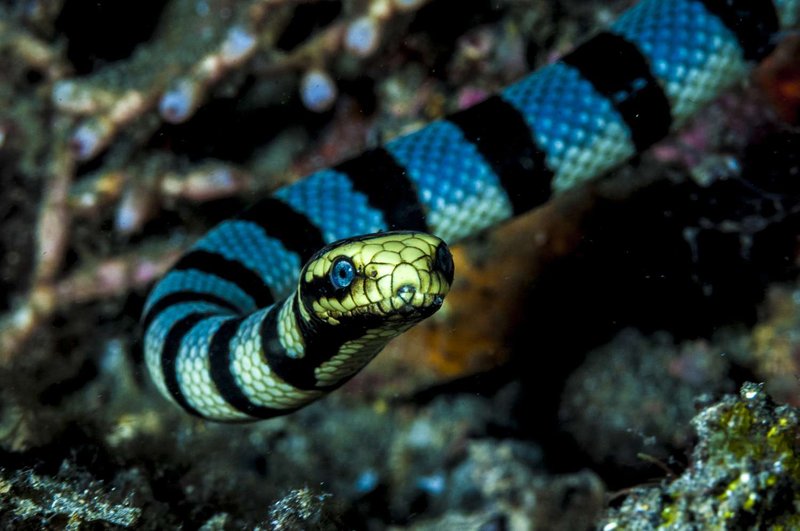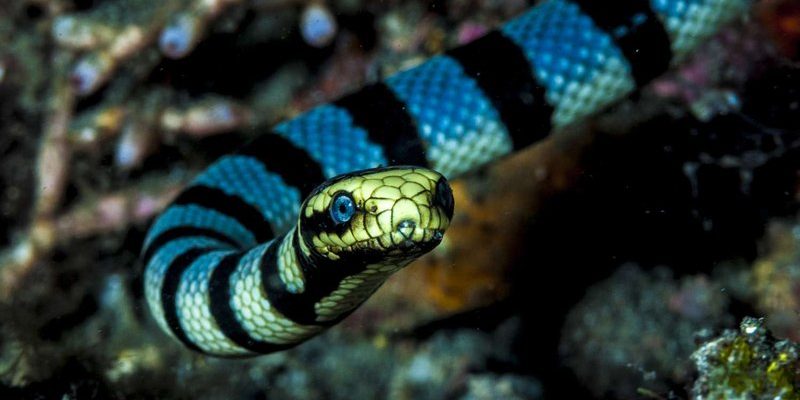
When you think of snakes, you might picture them slithering through grass or basking on a sunny rock. But have you ever thought about the sea snake? These fascinating creatures spend their lives in the ocean, gliding through the water with the grace of a dancer. They are both beautiful and mysterious, with their vibrant colors and unique adaptations for life in the sea. Just like a good book draws you in, sea snakes are full of interesting stories beneath the waves.
Imagine a snake that can dive deep, swim gracefully, and even hold its breath for long periods. Sounds cool, right? Sea snakes are like the superheroes of the reptile world, having adapted to life in some of the most challenging marine environments. But, there’s more to them than just their impressive swimming abilities. They play vital roles in their ecosystems, helping keep marine populations in balance. Let’s dive deeper into the world of sea snakes and explore what makes them so remarkable!
What Are Sea Snakes?
Sea snakes belong to the family Elapidae, which is the same family that includes cobras and mambas. They are highly specialized reptiles that have adapted to living in marine environments. This family consists of over 70 different species, each with unique traits and behaviors. Unlike their land-dwelling cousins, sea snakes have flattened bodies that help them swim more efficiently, almost like they’ve traded in their legs for fins.
Most sea snakes are non-aggressive, preferring to swim away from humans rather than confront them. However, they are venomous and can deliver a painful bite when threatened. But don’t let that scare you! The vast majority of sea snakes are not interested in interacting with us at all. They’d much rather enjoy their underwater world, hunting for fish and other small prey.
Where Do Sea Snakes Live?
Sea snakes are primarily found in the warm coastal waters of the Indian and Pacific Oceans. Their habitats include coral reefs, lagoons, and even the open ocean. While they can sometimes be seen basking on land, they generally spend most of their lives in the water. Coral reefs are especially important for them, as these vibrant ecosystems provide excellent hiding spots and abundant food sources.
Each species of sea snake has its preferred habitat range. For instance, the Olive Sea Snake loves the shallows of coastal waters, while the Yellow-bellied Sea Snake can often be found far from the land, swimming along the surface. These adaptations allow them to thrive in various environments, showcasing their resilience and resourcefulness.
Diet and Feeding Habits
Sea snakes are primarily carnivorous, with a diet mainly consisting of fish, eels, and occasionally crustaceans. They are skilled hunters, using their keen eyesight to spot prey in the water. When hunting, they may use a method known as “ambush foraging,” where they patiently wait for their prey to come close before striking. This is similar to a cat stalking a mouse, patiently waiting for the perfect moment to pounce.
One remarkable feature of sea snakes is their ability to eat prey that is much larger than their heads. They can unhinge their jaws, similar to how some land snakes do, allowing them to swallow larger fish whole. Once they’ve secured a meal, they rely on their potent venom to immobilize their prey before consuming it. So, while you might think of snakes as creepy-crawly creatures, sea snakes have their own unique finesse in the world of marine hunting.
Physical Characteristics
Sea snakes exhibit a variety of striking colors and patterns, often serving as camouflage to blend into their surroundings. Some species have yellow or black bands, while others boast vibrant blues and greens. This coloration helps them hide from both predators and prey, making them effective hunters in their habitats. Size-wise, they generally range from about 3 to 10 feet long, depending on the species.
Their bodies are streamlined and flattened, making it easy for them to swim. A sea snake’s tail is powerful, enabling it to propel through the water with ease. Many sea snakes also possess specialized scales that help them glide through the ocean smoothly. Think of them as the Formula 1 race cars of the marine world—built for speed and performance!
Reproduction and Lifespan
Sea snakes typically reproduce through a method called ovoviviparity, meaning that they give birth to live young instead of laying eggs. This is a significant adaptation since it allows the young to be born in the safety of the water. The young are often quite small but are miniatures of their parents, ready to fend for themselves soon after birth. Depending on the species, females can give birth to anywhere from a few to over a dozen offspring at a time.
As for their lifespan, sea snakes can live quite long, often reaching over 10 years in the wild. Some species are even known to live for up to 20 years! Like many creatures, their lifespan can be influenced by factors such as predators, food availability, and habitat conditions. In the right environment, a sea snake can thrive for decades, adding to the beauty and complexity of marine life.
Conservation Status
Many sea snake species face threats from habitat destruction, pollution, and climate change. Coral reefs, which are essential to their survival, are under severe stress from warming oceans and rising sea levels. Additionally, fishing practices can accidentally catch sea snakes, leading to declines in their populations. It’s important to raise awareness about these magnificent creatures and encourage conservation efforts to protect their habitats and ecosystems.
Efforts are underway in many regions to mitigate these threats, including marine protected areas and research initiatives aimed at understanding sea snake populations better. By working together to protect their ocean homes, we can help ensure that sea snakes continue to grace our waters for generations to come.
Interesting Facts
| Average Length | 3 to 10 feet |
| Habitat | Warm Indian and Pacific Oceans, often near coral reefs |
| Diet | Fish, eels, and other small marine animals |
| Reproduction | Live birth, with females giving birth to several young |
| Life Span | 10 to 20 years |
| Venom | Highly venomous, but rarely aggressive towards humans |
Myths and Misconceptions
There are plenty of myths surrounding sea snakes that can make them seem scarier than they really are. One common misconception is that all sea snakes are dangerous. While it’s true that they have venom, they are generally not aggressive and will often swim away if they see a human nearby. Most bites happen when a snake feels threatened or is accidentally stepped on, just like with many land snakes.
Another myth is that all sea snakes can breathe underwater. While sea snakes are great swimmers, they are still reptiles and need to surface for air. They can hold their breath for an impressive amount of time—often over an hour—but they do need to surface periodically. So, if you ever see a sea snake swimming, remember that it’s just as much a part of the ocean as the fish and coral surrounding it!
FAQ
Are sea snakes poisonous?
Yes, sea snakes are poisonous, and they possess highly potent venom. However, they are generally not aggressive towards humans and prefer to avoid contact. Most bites occur accidentally when they feel threatened. Although their venom is dangerous, fatalities from sea snake bites are rare, largely due to their tendency to swim away from human interaction.
How do sea snakes hunt?
Sea snakes are skilled hunters, primarily using their keen eyesight to locate prey such as fish and eels. They often employ ambush tactics, waiting patiently for their food to come close before striking. Their ability to unhinge their jaws allows them to consume prey larger than their heads, making them effective predators in their underwater environments.
Can sea snakes breathe underwater?
No, sea snakes cannot breathe underwater. Like all reptiles, they need to come to the surface to breathe air. However, they can hold their breath for a considerable amount of time—often around an hour—allowing them to dive deep and explore their ocean habitats.
What do baby sea snakes look like?
Baby sea snakes are miniatures of their adult counterparts, often measuring just a few inches long at birth. They possess the same physical characteristics, including color patterns, which help them camouflage into their surroundings from an early age. These young snakes are independent immediately after birth and must learn to hunt and survive on their own.
Are sea snakes endangered?
Some species of sea snakes are threatened or endangered due to habitat loss, pollution, and climate change. Conservation efforts are essential to protect their habitats, especially coral reefs, which are vital for their survival. Raising awareness about the importance of these creatures can also contribute to their protection.
How long do sea snakes live?
Sea snakes typically have a lifespan of 10 to 20 years, depending on the species and environmental conditions. Factors such as food availability, predators, and habitat quality can influence their lifespan. In optimal conditions, they can thrive for many years, enriching the marine ecosystem.
Do all sea snakes have the same diet?
While all sea snakes are carnivorous, their diets can vary based on species and habitat. Most primarily feed on fish and eels, but some may also consume crustaceans and other marine life. This specialization allows them to adapt to their particular environments and available food sources.
Where can I find sea snakes?
Sea snakes are mostly found in the warm coastal waters of the Indian and Pacific Oceans. They inhabit areas such as coral reefs, lagoons, and sometimes even the open ocean. If you’re interested in observing them, snorkeling or diving in these regions can provide opportunities to see these fascinating creatures in their natural habitats.
What should I do if I encounter a sea snake while swimming?
If you encounter a sea snake while swimming, the best course of action is to remain calm and avoid sudden movements. Most sea snakes are shy and will swim away if given the opportunity. It’s prudent to keep a respectful distance and observe them from afar, allowing you to enjoy the experience without causing distress to the snake.

